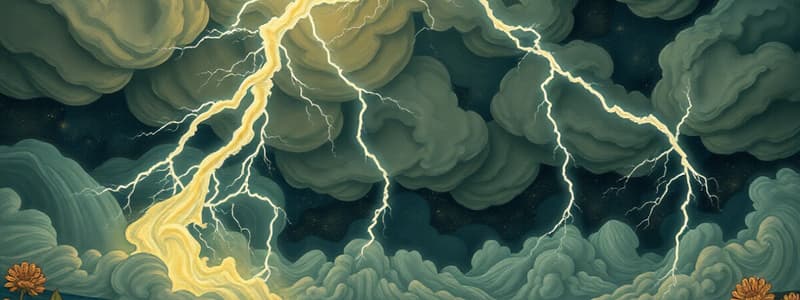Podcast
Questions and Answers
What characterizes the final stage of an ordinary thunderstorm?
What characterizes the final stage of an ordinary thunderstorm?
- The storm gains energy from downdrafts.
- The updraft continues to supply energy.
- The downdraft cuts off the updraft. (correct)
- The storm forms through strong wind shear.
What is a distinguishing characteristic of a supercell thunderstorm?
What is a distinguishing characteristic of a supercell thunderstorm?
- There is no significant wind shear present.
- It can spawn tornadoes under certain conditions. (correct)
- Storms last for only a short duration.
- It has a diameter of less than 1 km.
How does a multi-cell thunderstorm differ from an ordinary thunderstorm?
How does a multi-cell thunderstorm differ from an ordinary thunderstorm?
- The downdraft forms directly above the updraft.
- It can induce the formation of additional storms. (correct)
- It has no wind shear present.
- It is consistently smaller in diameter.
What hazard is associated with microbursts?
What hazard is associated with microbursts?
Which of the following is true about the downdraft in a supercell thunderstorm?
Which of the following is true about the downdraft in a supercell thunderstorm?
What is the characteristic wind direction of tornadoes as they typically rotate?
What is the characteristic wind direction of tornadoes as they typically rotate?
What is the primary meteorological condition for the formation of tornadoes?
What is the primary meteorological condition for the formation of tornadoes?
Which of the following is true about the funnel cloud preceding a tornado?
Which of the following is true about the funnel cloud preceding a tornado?
What is a common characteristic of thunderstorms?
What is a common characteristic of thunderstorms?
What does the Enhanced Fujita Scale primarily account for when classifying tornadoes?
What does the Enhanced Fujita Scale primarily account for when classifying tornadoes?
What are the stages of an ordinary thunderstorm?
What are the stages of an ordinary thunderstorm?
Which condition is NOT necessary for tornado formation?
Which condition is NOT necessary for tornado formation?
What are mesoscale convective complexes characterized by?
What are mesoscale convective complexes characterized by?
What role does latent heat play in the development of thunderstorms?
What role does latent heat play in the development of thunderstorms?
Which wind speed category on the Fujita Scale indicates 'Incredible Damage'?
Which wind speed category on the Fujita Scale indicates 'Incredible Damage'?
What is a typical lifespan of an average squall line?
What is a typical lifespan of an average squall line?
How does lightning primarily form within a thunderstorm?
How does lightning primarily form within a thunderstorm?
What is one of the main limitations of the original Fujita Scale?
What is one of the main limitations of the original Fujita Scale?
Which of the following categories of thunderstorms is characterized by significant vertical wind shear?
Which of the following categories of thunderstorms is characterized by significant vertical wind shear?
What event is noted as an example of a severe squall line impact?
What event is noted as an example of a severe squall line impact?
What happens during the mature phase of an ordinary thunderstorm?
What happens during the mature phase of an ordinary thunderstorm?
What feature forms as the vortex tube in the atmosphere begins to rotate vertically?
What feature forms as the vortex tube in the atmosphere begins to rotate vertically?
What triggers the formation of a gust front in a thunderstorm?
What triggers the formation of a gust front in a thunderstorm?
What temperature can air reach in a lightning strike?
What temperature can air reach in a lightning strike?
In the formation of lightning, which particles tend to rise to the top of the storm?
In the formation of lightning, which particles tend to rise to the top of the storm?
How do large thunderstorms potentially lead to the formation of tornadoes?
How do large thunderstorms potentially lead to the formation of tornadoes?
What is a key feature of the main part of the lightning flash?
What is a key feature of the main part of the lightning flash?
Which condition is NOT a necessary factor for the development of a thunderstorm?
Which condition is NOT a necessary factor for the development of a thunderstorm?
What is a major characteristic of squall lines?
What is a major characteristic of squall lines?
What is the primary reason hailstones form in cumulonimbus clouds?
What is the primary reason hailstones form in cumulonimbus clouds?
Which region in the United States typically experiences the most hail days?
Which region in the United States typically experiences the most hail days?
What characteristic of hailstones contributes to their potential damage?
What characteristic of hailstones contributes to their potential damage?
Which of the following best describes the process by which hailstones grow?
Which of the following best describes the process by which hailstones grow?
What is the significance of the World Wide Lightning Location Network?
What is the significance of the World Wide Lightning Location Network?
What phenomenon does the acronym ENSO represent in relation to thunderstorms?
What phenomenon does the acronym ENSO represent in relation to thunderstorms?
During which time of day do thunderstorms typically peak in Florida?
During which time of day do thunderstorms typically peak in Florida?
What is the largest hailstone recorded in Canada according to recent data?
What is the largest hailstone recorded in Canada according to recent data?
How many cloud droplets are estimated to form a golf ball-sized piece of hail?
How many cloud droplets are estimated to form a golf ball-sized piece of hail?
What characterizes the worldwide distribution of thunderstorms according to seasonal probability?
What characterizes the worldwide distribution of thunderstorms according to seasonal probability?
Flashcards are hidden until you start studying
Study Notes
Thunderstorms
- Thunderstorms are violent storms that cause heavy precipitation, strong gusts of wind, and thunder and lightning.
- Thunderstorms are also known as convective storms.
- Surface heating causes thunderstorms to form.
- Thunderstorms are characterized by cumulonimbus clouds.
- As air rises in the cloud, it cools and some of its water vapor condenses.
- The condensation releases latent heat, warming the surrounding air.
- Ordinary, multi-cell, supercell, and mesoscale convective complexes (MCCs) are four categories of thunderstorms.
- Ordinary thunderstorms often develop within large air masses and are not necessarily near a frontal system.
- They have little vertical wind shear.
- Ordinary thunderstorms have three stages:
- Developing
- Mature
- Dissipating
- Multi-cell thunderstorms have moderate wind shear that tilts the storm, allowing the downdraft to form downwind of the updraft.
- Supercell thunderstorms form with strong vertical wind shear and can spawn tornadoes.
- Supercells can last for several hours.
- Microbursts are localized downdrafts that can create strong wind shear when they reach the surface.
- MCCs are multiple thunderstorms organized in a circular fashion.
- Squall lines are a series of very vigorous cumulonimbus clouds that merge to form a continuous line and advance at right angles to the line itself.
Lightning
- Lightning is an electrical discharge that neutralizes a charge separation that has accumulated within a cloud between two clouds, or between a cloud and the ground.
- Most (90%) lightning starts at the cloud base and goes to the surface.
- The first step of the process is the ionization of a path of about 50 m by 3 million volts of electricity.
- The air heats to 30,000º C, generating a shock wave which is heard as thunder.
- Lightning detection can be done by detecting radio waves (sferics) that are produced during lightning.
Hail
- Hail is a precipitation in the form of hailstones, which are hard, more or less spherical pieces of ice.
- Hail stones form in cumulonimbus clouds.
- Golf ball-sized hail stones require 10 billion cloud droplets.
- The leeward side of the Rockies has the most hail days in the United States.
Tornadoes
- Tornadoes form when a rapidly rotating column of air reaches the ground.
- Tornadoes are also known as funnels or twisters.
- A funnel cloud is the precursor to a tornado.
- Tornadoes are typically counterclockwise and 100–600 m in diameter.
- Tornadoes are usually short-lived and can produce peak winds over 400 km/h.
- Tornadoes are formed from supercell thunderstorms.
- Wind shear causes the formation of the vortex tube.
- In a supercell thunderstorm, the updraft causes the rotating column of air (vortex tube) to take on a vertical component.
- When the vortex tube becomes vertical and reaches the ground, it becomes a tornado.
Tornado Classification
- The Fujita Scale classifies tornadoes based on the damage they cause.
- Developed in 1971 by Ted Fujita, the Fujita Scale uses a six-category system.
- The Enhanced Fujita Scale (EF-scale) was created to address some of the limitations of the original Fujita Scale.
- The EF-scale provides more accurate estimates of tornado wind speeds.
Thunderstorms and ENSO
- ENSO is a climate pattern that refers to the El Niño and La Niña phases.
- During El Niño, warmer-than-average sea surface temperatures are present in the central and eastern Pacific Ocean.
- During La Niña, cooler-than-average sea surface temperatures occur in the central and eastern Pacific Ocean.
Studying That Suits You
Use AI to generate personalized quizzes and flashcards to suit your learning preferences.




